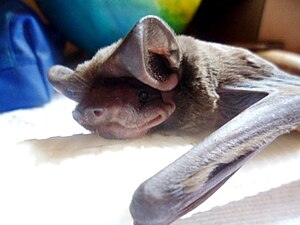Wagner bulldog bat
| Wagner bulldog bat | ||||||||||||
|---|---|---|---|---|---|---|---|---|---|---|---|---|

Wagner's bulldog bat ( Eumops glaucinus ) |
||||||||||||
| Systematics | ||||||||||||
|
||||||||||||
| Scientific name | ||||||||||||
| Eumops glaucinus | ||||||||||||
| ( Wagner , 1843) |
The Wagner bulldog bat ( Eumops glaucinus ) is a species of bat from the family of bulldog bats and native to Central and South America. The species name "glaucinus" is probably derived from the Greek "glaukos" (silver, shiny).
description
With a forearm length of 60.4 to 61.2 mm and a weight of 30.2 to 46.6 g, the Wagner bulldog bat is smaller than the western bulldog bat ( Eumops perotis ) and larger than the Guyana bulldog bat ( Eumops maurus ). The species is about the same size as the black capped bulldog bat ( Eumops auripendulus ), but differs in its pale coat color, with a higher contrast between the abdominal and dorsal fur. In addition, the Wagner bulldog bat has a wider tragus and a longer and proportionally wider head. The ears are wider than they are long and when folded forward protrude beyond the muzzle. Weight and size differ regionally. In Cuba, the average weight of males is 36.6 g, that of females is 37.3 g, in Mexico the males weigh 35.9 g and females weigh 34.4 g. In Venezuela, the average weight of males is 33.8 g and that of females is 32.5 g. The wings of the Wagner bulldog bat are among the narrowest of all bulldog bats , which makes the species a fast flyer over long distances. The Wagner bulldog bat, however, is difficult to maneuver in a small space due to its fast flying and relatively large body size. The wingspan is 409-470 mm. The coat color varies from black to brown-gray to cinnamon. The hair is two-tone with a light base and a darker tip. In contrast to females, males have a throat pouch and are slightly larger. In addition, males have a scent gland on their throats, with which a musky scent is produced, which is probably important for courtship .
Way of life
The Wagner bulldog bat , like most bats, is nocturnal and feeds primarily on insects. Their calls are - unusually for bats - so deep that they can also be heard by the human ear. During the day, the animals usually hide in buildings, tree hollows and under tree bark. The groups are often small and usually consist of one male with several females. Eumops glaucinus sometimes shares the hiding spots with Molossus molossus , Molossus ater , Tadarida laticaudata and Mormopterus minutus . Well-known predators of the Wagner bulldog bat are the great spotted falcon and various species of owls . The species is polyestrial . Only one young animal is born per litter.
distribution
The Wagner bulldog bat is found in Peru , Bolivia , Paraguay and northern Argentina . The IUCN classifies the population as safe due to its wide distribution.
Web links
literature
- T. L Best, WM Kiser, J. C Rainey: Eumops glaucinus. In: Mammalian Species . No. 551, 1997, pp. 1-6.
swell
- ^ Theodor CH Cole: Dictionary of Mammal Names - Dictionary of Mammal Names . 1st edition. Springer-Verlag, Berlin Heidelberg 2015, ISBN 978-3-662-46269-0 .
- ↑ Eumops glaucinus in the IUCN Red List of Threatened Species .